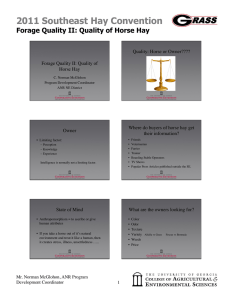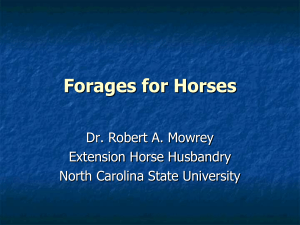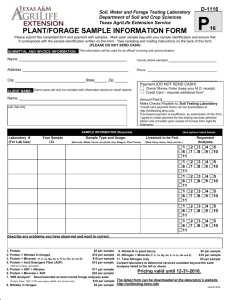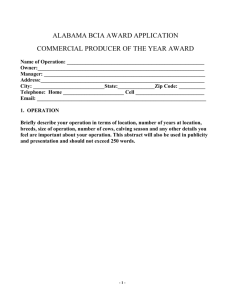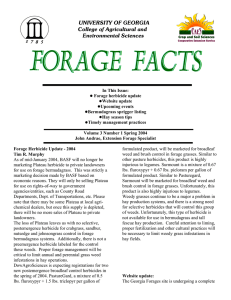Resolutions for Greener Pastures
advertisement
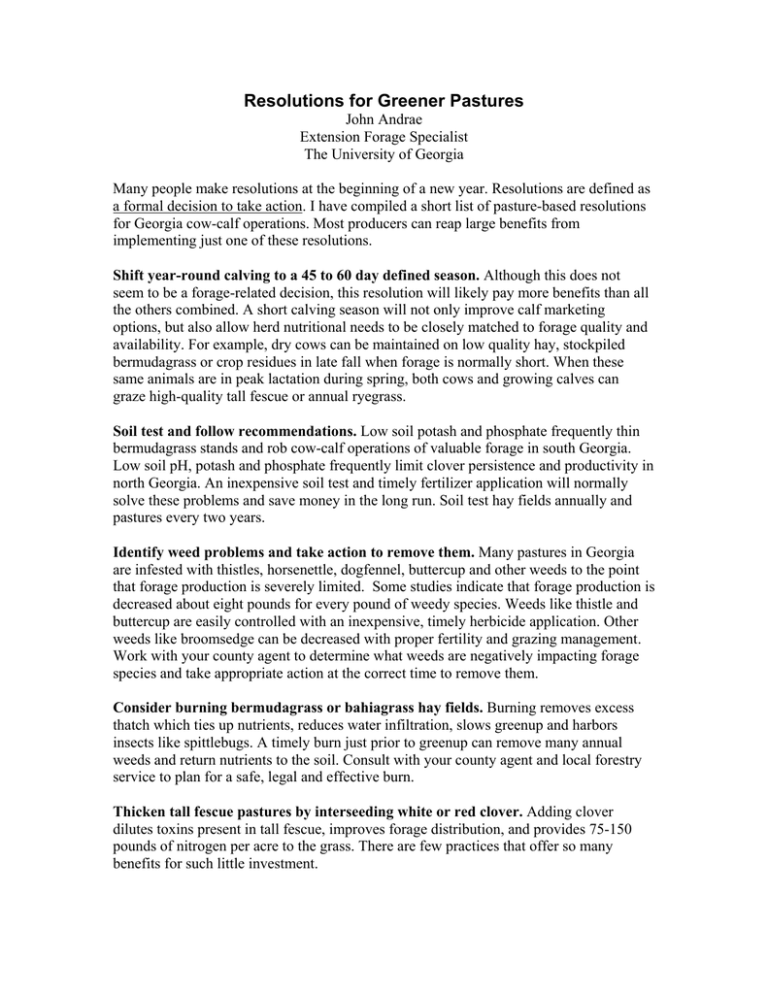
Resolutions for Greener Pastures John Andrae Extension Forage Specialist The University of Georgia Many people make resolutions at the beginning of a new year. Resolutions are defined as a formal decision to take action. I have compiled a short list of pasture-based resolutions for Georgia cow-calf operations. Most producers can reap large benefits from implementing just one of these resolutions. Shift year-round calving to a 45 to 60 day defined season. Although this does not seem to be a forage-related decision, this resolution will likely pay more benefits than all the others combined. A short calving season will not only improve calf marketing options, but also allow herd nutritional needs to be closely matched to forage quality and availability. For example, dry cows can be maintained on low quality hay, stockpiled bermudagrass or crop residues in late fall when forage is normally short. When these same animals are in peak lactation during spring, both cows and growing calves can graze high-quality tall fescue or annual ryegrass. Soil test and follow recommendations. Low soil potash and phosphate frequently thin bermudagrass stands and rob cow-calf operations of valuable forage in south Georgia. Low soil pH, potash and phosphate frequently limit clover persistence and productivity in north Georgia. An inexpensive soil test and timely fertilizer application will normally solve these problems and save money in the long run. Soil test hay fields annually and pastures every two years. Identify weed problems and take action to remove them. Many pastures in Georgia are infested with thistles, horsenettle, dogfennel, buttercup and other weeds to the point that forage production is severely limited. Some studies indicate that forage production is decreased about eight pounds for every pound of weedy species. Weeds like thistle and buttercup are easily controlled with an inexpensive, timely herbicide application. Other weeds like broomsedge can be decreased with proper fertility and grazing management. Work with your county agent to determine what weeds are negatively impacting forage species and take appropriate action at the correct time to remove them. Consider burning bermudagrass or bahiagrass hay fields. Burning removes excess thatch which ties up nutrients, reduces water infiltration, slows greenup and harbors insects like spittlebugs. A timely burn just prior to greenup can remove many annual weeds and return nutrients to the soil. Consult with your county agent and local forestry service to plan for a safe, legal and effective burn. Thicken tall fescue pastures by interseeding white or red clover. Adding clover dilutes toxins present in tall fescue, improves forage distribution, and provides 75-150 pounds of nitrogen per acre to the grass. There are few practices that offer so many benefits for such little investment. Resolve to replace 5-10% of toxic tall fescue acreage each year with a non-toxic forage. Non-toxic fungus-infected tall fescue will revolutionize beef production in the fescue belt. Make a firm decision to replace small amounts of your old toxic Kentucky 31 pastures every year. In a few years, herd conception rates and weaning weights will reward this decision. There are few production practices that will consistently improve weaning weights by over 50 pounds. Take advantage of this one. If water availability allows, subdivide large pastures with inexpensive polywire and begin a rotational grazing program. This simple practice can increase stocking rate and forage utilization, reduce forage waste, evenly distribute manure across the pastures, and improve overall pasture management skills. Plan now to reduce next winter’s stored feed needs. Hay costs are likely the largest expense of your beef cattle enterprise. Consider grazing crop residues like corn and cotton stalks, stockpiling bermudagrass or tall fescue pasture, using cheap byproduct feeds, and establishing cool season forages like tall fescue or winter annuals. Each of these practices will decrease hay requirements. Cover hay to minimize weathering losses. Georgia’s wet and warm winters are ideal for mold growth in stored hay. Many research trials indicate that over 30% of hay is lost to weathering and an additional 20% of remaining hay is refused by animals. A 50% hay loss is unprofitable and unacceptable. Store hay under barns when possible and tarp hay that is stored outdoors. If only a portion of hay can be stored under cover, leave low quality hay outdoors and feed it first. Harvest bermudagrass hay at strict 4-5 week intervals and test hay for quality. Frequent harvests improve hay quality. It’s easier and cheaper to harvest quality hay than to supplement poor quality hay. Testing each hay cutting allows appropriate forage quality to be paired and fed to animals at an appropriate physiological stage. Educate yourself about forage management. Knowledge is power. Continue to read and learn about forage production and management. There are many seminars, workshops and cattleman’s meetings held throughout Georgia and in adjacent states. For example, the University of Georgia will host a two day Grazing School on March 14th and 15th 2005. Soil fertility, rotational grazing, overseeding techniques, and many other topics will be covered at this workshop. For a complete agenda and registration application see your local county agent or visit www.georgiaforages.com . Take time out of your schedule and make a firm decision to implement one or two of these resolutions in your operation. Once the decision is made, take action and implement the plan. Each of the above practices will improve overall forage management and increase the bottom line on your cow-calf operation.

